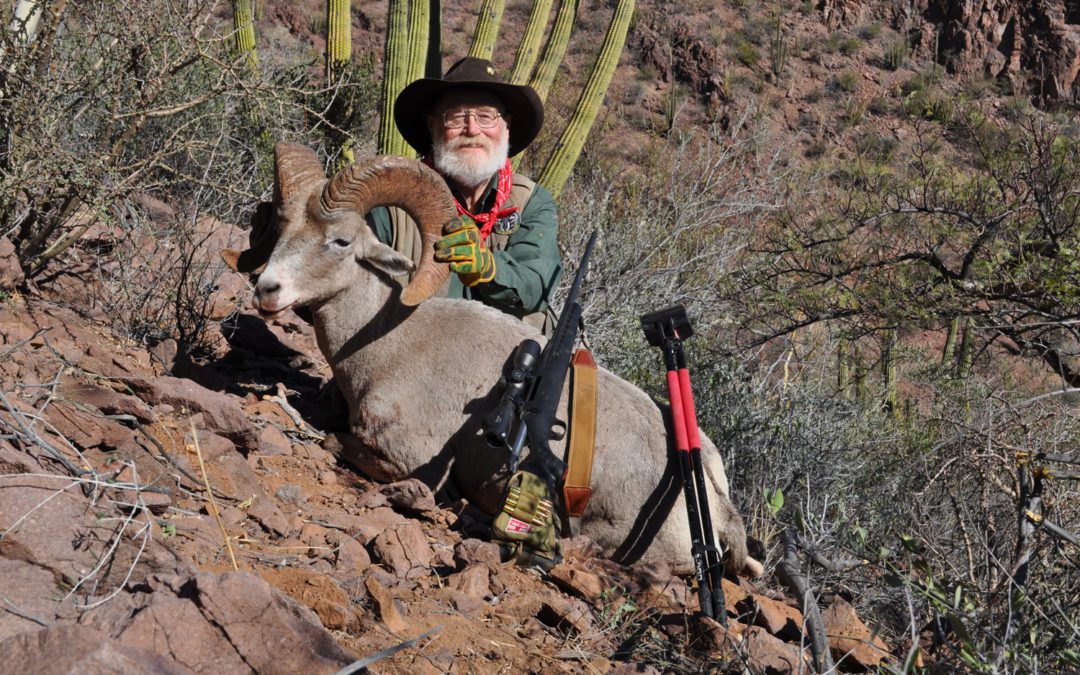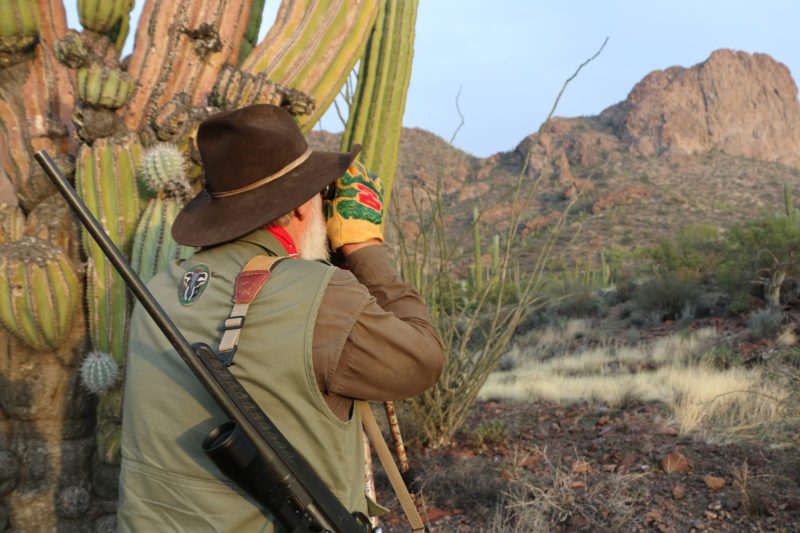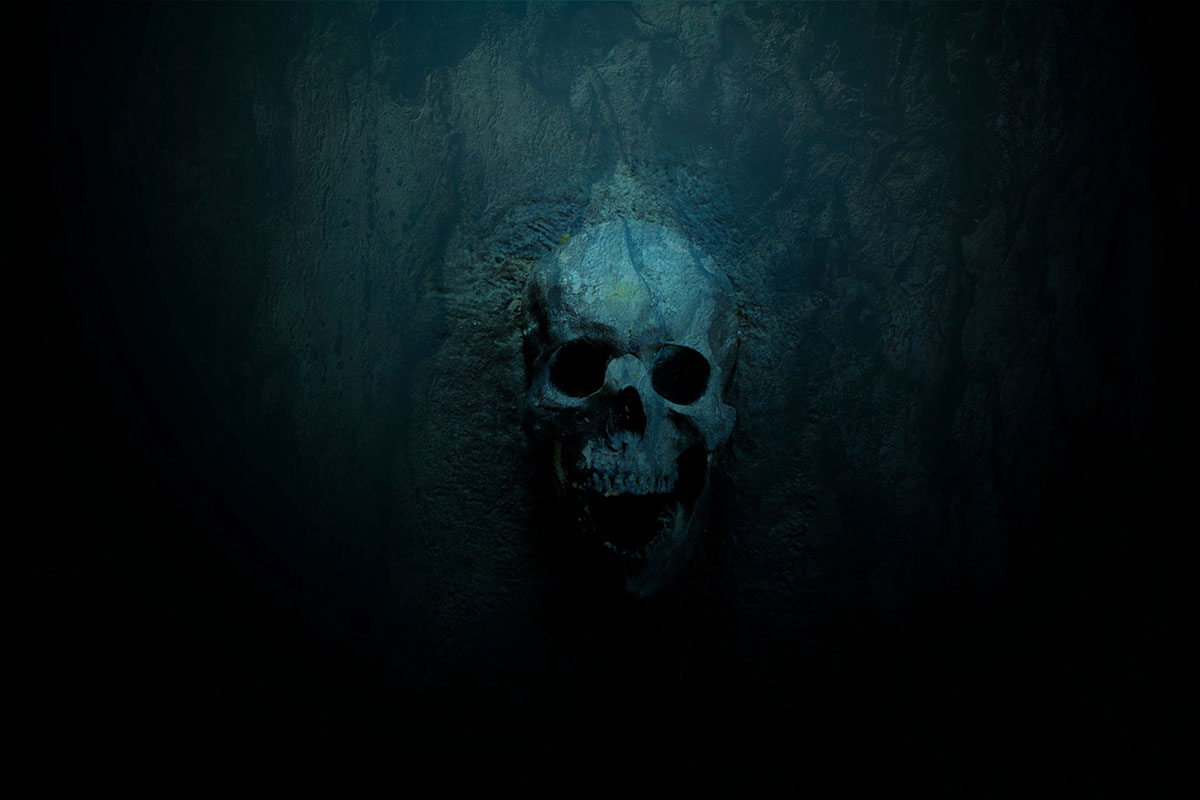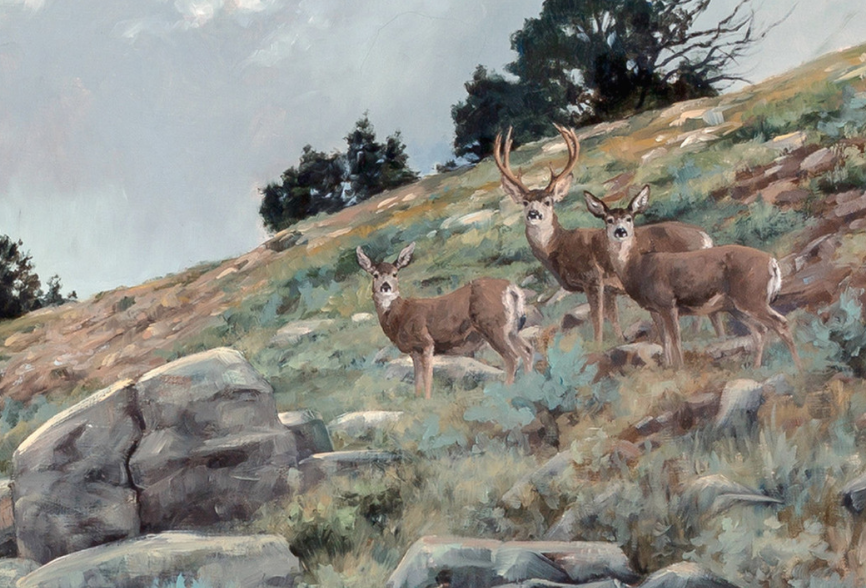It was a dream come true working with desert bighorns for research, and soon my dream of taking a bighorn ram would be realized.
Less than 75 yards away the desert bighorn ram was indeed going down! As he faltered, I took off running. The ram staggered and fell. I jumped over a doghouse-sized rock and grabbed the ram. No way was he going to get away from me! I had spent days getting into position for a clear shot. Finally, it had happened.
My shot, thankfully, had been true – right on target. The ram kicked and bucked but I held on for dear life! No way was I going to let go. I could hardly control myself. I finally had my hands on a desert bighorn ram! Holding onto the ram, my arm wrapped around his curling horns, I reached into my pocket with the other hand; fumbled around and finally pressed the talk button on my radio. “Got him! Send the trailer!” Trailer???
A few minutes later the haul trailer arrived. I grabbed the ram and carried him to it, gave him several “shots” of antibiotics and vitamins, then pushed him up and in.
Hours later we pulled into Texas’ Sierra Diablos Wildlife Management Area and released him in to a large enclosure to be part of an on-site desert bighorn sheep breeding program. I remember telling those present, “I may never shoot a desert bighorn to put on my wall, but by golly, I’ve shot one with a tranquilizer gun!”
That was back in the early 1970’s when I worked as a research biologist with Texas’ Wildlife Disease Project based out of Texas A&M University. It was a dream come true working with desert bighorns. My wife, Mary Anne, and I bottle-raised three desert lambs for research I was involved in at the time.
I had first read about desert bighorn sheep as a youngster in stories by Jack O’Connor as he wrote about his exploits in Sonora, Mexico. I dreamed of some day doing the same. My dream of taking a desert ram never went away! For many years I applied for desert bighorn sheep permits in every state that offered hunts. But, lady luck seemed to frown upon me.
In time, I started hunting Sonora, Mexico for Coues deer, which is much like hunting desert bighorns. It was my substitute for hunting sheep. It was there I met Ariel Trevino, a biologist who works with landowners throughout Mexico setting up quality wildlife management programs and helping with their hunting programs.
During the summer of 2012 I was visiting with Ariel and discussing Coues whitetail. “Larry, I’ve been talking to a landowner,” he told me. “I told him about you, and he wants you to hunt deer with him. Let’s call him.”
We did, and I quickly worked an agreement for hunting Coues deer. As I was about to hang up, the rancher asked, “Have you ever hunted desert bighorn?” I quickly explained my experiences with desert sheep and a lifetime desire to do so.
A couple of weeks later I received a call. “I have one desert sheep permit left to sell. If you are interested, I’ll make you a very special deal!” Moments later I committed to a desert sheep hunt!
Prior to heading to Mexico, I headed to the FTW Ranch/SAAM (Sportsman All Weather All Terrain Marksmanship) ranges. I sighted my .270 Win, Ruger American Rifle in with Hornady’s American Whitetail ammo, 130-grain Interbond bullets. Five shots at 100 yards made one small ragged hole. I then shot at ranges out to 750 yards.
I hardly slept before my sheep hunt. I could not think of anything else. Finally, the day arrived for my “DSC’s Trailing the Hunter’s Moon” cameraman, Derek Harris and me to fly to Hermosillo, Sonora. After quickly clearing Mexican customs, we were met by Chapo Juvera, with whom I had previously hunted Coues and mule deer.
We drove a couple of hours in a southwesterly direction, passed through several gates and finally arrived at the ranch’s headquarters. As we stowed our gear I was introduced to the ranch’s owner and his local vaqueros, who spend much time looking for sheep. After supper we headed to the rifle range. The two Hornady shots from my Ruger rifle went into the same hole, a half-inch above the “X” at 100 yards. My rifle was ready!
First morning, I was dressed and ready to go at least two hours before anyone else got out of bed! After breakfast we headed to the north part of the ranch. There we set up spotting scopes and glassed the rough and rocky terrain. Immediately we spotted two rams 800 yards away – both really nice. I looked at Chapo who peered through the scope. “Shooters?” I asked. “The one on the right looks to be the bigger of the two. What do you think?”
“I think we can do better,” replied Chapo. “They’re both probably right at thirty inches. One is more massive than the other.” I continued glassing the two rams. I heard Chapo say, “There are more rams far to the right, just on the lower edge of the shadow of the big canyon on the reddish mountain.”
I turned and spotted the rams. All looked good to me, but I noticed they were actually smaller than the ones I had just seen. I counted eight rams. It looked like there might be more in the tall brush. I “marked” the exact spot, then switched to a spotting scope. Cranking up to 40x I looked over each of the rams. Two were about the same size as those earlier.
Even though I was there with rifle in hand, I still found it hard to believe I was finally, really hunting desert bighorn sheep!
A few minutes later Chapo suggested we move on. We walked back to the pickup and headed deeper into sheep country.
We drove to a point, stopped and walked a half mile. There we set up to glass where we could cover three different slopes.
During the next hours we spotted 37 sheep, including 17 rams, 15 ewes and five lambs. Three of the rams were definitely older with massive horns. They were a mile away, but even at that distance they looked really good.
About mid-afternoon one of the ranch hands suggested we make a move and head to the other side of the ridges to take advantage of the afternoon sun. We walked back to the pickup and started the long drive to that area. While doing so we spotted a couple of huge desert mule deer bucks, as well as one dandy Coues buck.
We parked and walked three miles to a spot where we could glass the slopes and ridges of a wide, rugged canyon. No sooner had we set up when we spotted nine rams a mile away. But then 700 yards away, we saw three more rams. We also found a small herd of ewes and half-grown lambs on another slope. I mentioned the rams looked good to me. Chapo smiled, “Let’s keep looking!” I did not complain!
I will admit, I loved glassing for sheep and even though I really wanted to shoot one, just hunting sheep was extremely exciting and satisfying. I spent a lot of time watching sheep; wanting to learn as much as I could. What they fed on and how they interacted with each other for instance. I had in years past back in Texas watched and often heard rams banging heads. It always amazed me how loud those sounds were. The breeding season was nearly over when my hunt occurred, but some rams were still head-butting.
When the sun dropped behind rugged peaks we headed back to camp. I was tired but still so excited that I slept very little. Up early I waited for others to rise. After breakfast we headed back to the mountains driving to near where we had been the day before.
Midmorning we spotted rams a long way off. Through spotting scopes, we could tell they were young rams, three- and four-year olds. Mid-afternoon we moved deeper into a huge valley. Walking around a bend, we spotted two sheep. One was young, but the other was a massive-horned, mature ram. The older ram immediately spotted us. He took off running even though we were a long way from him. He looked really good.
A couple of hours later we saw him again well over two miles away. We hiked back to the vehicle and headed to the other side of the ridge, a very long circuitous drive. Two vaqueros decided to head toward the ram, follow him and hopefully put him to bed so we would know where to start in the morning.
We walked three miles to where we should be able to see the big ram we’d seen earlier. At dark we met the two vaqueros. They had bedded the ram.
Next morning everyone was up early. At the base of the mountain, Chapo and the ranch owner, as well as Juan, who had been in on over 200 desert bighorn sheep kills, conferred and came up with a plan.
They decided Chapo, Juan, Derek and I should head toward the ridge beyond which the ram was supposedly bedded. On our climb we nearly ran into two rams about 150 yards distant. Both were mature and really nice! But we skirted them and headed farther up the ridge.
We spotted several more rams 800 yards away to our right and quickly glassed them. I could see there were several mature rams in the group. I questioned Chapo about these rams. Chapo questioned Juan. Juan pointed up the ridge to keep moving.
We kept crawling toward a high saddle. Supposedly the ram I was after was just beyond. As we neared the saddle, Juan and Chapo eased up to peer through the notch in the rocks. I heard Chapo ask Juan in Spanish if the ram they were looking at was the one we wanted. He nodded an affirmative. Chapo asked him a second time, and again Juan nodded in a positive manner. It was then Chapo motioned me to join them.
There I set up my shooting sticks. I spotted the ram 200 yards away. There were actually two rams, a less-than-half curl, and the one Juan wanted me to shoot. I got the crosshairs on the chosen ram, checked to make sure Derek was on him with his camera…then pushed the American’s tang safety to fire.
I took a deep breath and proceeded to jerk the trigger, missing my first shot. Desert bighorn fever had hit me hard! I bolted in a second Hornady round. The ram moved downward, but then turned up slope. I followed him through my scope and waited for him to turn broadside. He did, and this time I remembered to gently tug the trigger. I saw the ram stumble. I quickly bolted in another round and got the crosshairs back on target. I was just about to send another round when I heard Chapo say “He’s going down!” I had watched my ram fall but kept the crosshairs solidly on him for the better part of 90 seconds to make certain he was not going to get up. Only then was I ready to accept congratulations from Chapo and Juan.
A short time later we slid down the steep slope, then crawled to where my ram lay. At his side I marveled at my desert bighorn sheep. I was a sheep hunter, a successful sheep hunter! I recalled the many years I had dreamed of this exact moment. I offered a prayer of thanks. My desert bighorn dream had finally been realized!





